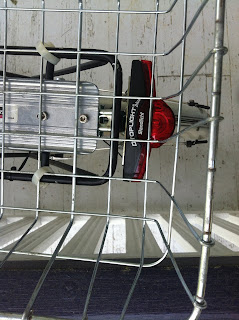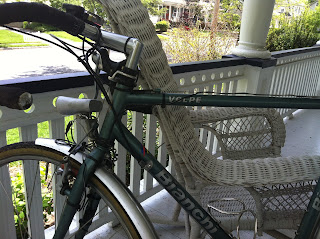Now that I've been riding with my dynamo hub a while, I'll give you the update I promised seven months ago.
I've replaced the headlight with a more powerful model. I did this not because I was dissatisfied with the B&M headlight. I was perfectly satisfied with it. A friend was placing an order with xxcycle in France, and he gave me a chance to add to it. I got a good deal on this light, and I figured the B&M could go on my wife's bike or another bike of mine. The B&M is rated at 40 Lux, and this Philips is rated at 60 Lux. It also has a white reflector which faces forward. I'm pretty sure I notice the increase in output, and that's a good thing. I think I have hit a speed of about 25 mph on an unlit road, and I was comfortable at that. That says a lot. Going faster than that on an unlit road is a luxury, not a necessity, at least to me.
In this picture, you see the headlight attached to a front rack on the bike. I attached a metal bracket to the rack and the light to the bracket.
This resulted in too much bouncing up and down. I could have stiffened it, but I decided I didn't need the rack at all, so now the headlight is attached to the fork in the traditional way.
I've devised my own wiring system. I used little lugs to attach to the hub. The wires from the lugs go to a female DC power connector. This allows for quick removal and replacement of the wheel. I have a vision of a wiring setup which would allow easy removal and replacement of the lights, rather than having them permanently mounted and wired. That is a future project, which I might or might not do. As it is currently, I can attach different lights to a different bike, and if I use the same kind of connector on the other bike, I can move this wheel from this bike to the other bike, provided they use the same size wheel. This is a 700c wheel with 32mm-wide tires, and many bikes use wheels like that. Most of my bikes use 700c wheels.
The taillight is attached to the rear rack.
Wiring goes from the hub, up the fork, to the headlight, out of the headlight, up the head tube, and wrapped around the brake cable which runs along the top tube. From there it runs under the rear rack and to the taillight.
The DC connectors are the type used for powering CCTV cameras. I soldered the connections and use heat-shrink tubing for permanent insulation.
Operation
The hub has no on/off switch. The drag increases as electrical load increases. With no load, the drag is noticeable to the fingers but not in the riding of the bike. With one light or both lights on, the drag goes up, but I still don't notice it on the bike. At high speed, I feel a slight vibration at the handlebar. It's not annoying, especially since I know what causes it.
The taillight also has no on/off switch, so it runs unless I don't connect the hub's wiring.
The headlight has an on/off switch, but since drag seems negligible, and since having a headlight on during the day might be a useful thing, I just leave it in the on position.
It's easy to adjust the headlight's up/down position while riding the bike. The bolt that holds the light to the bracket allows me to make it possible to turn it on the horizontal axis without letting the light flop on that axis from vibration. I'm sure this is deliberate, and I appreciate it. If there is significant oncoming traffic, I point the light slightly down so it doesn't shine in people's eyes. If the road is dark and has little traffic, I'll point it up a bit more so I can light up the road farther ahead.
The lights flash when I'm moving at low speed. This is a side effect of the output of the dynamo. I believe all bike dynamos put out alternating current, so the voltage reaches zero a few times a second, at a rate proportional to rotational speed. The flashing might be a good thing, or it might be a neutral thing. It doesn't bother me, and I don't think it bothers anyone else, either, since battery-powered flashing lights are so common here in the US. They may even be more common than continuously lit lights.
Overall impression
This setup is so good that I prefer to use this bike whenever I need to ride anywhere. I know that the light will have power, and I don't have to mind the charging state of any batteries. If I ride for longer than expected, there is no battery to run down. I expect that this system will need far less maintenance per mile than nearly any battery-powered system. One reason is, of course, that I'm providing the power. Another is that the system is permanently mounted to the bike. One advantage is that I may not want to lock this bike up in areas where thieves like to grab whatever they can off bikes parked in public.
Still to do
The wiring for the headlight is too long, since the headlight was farther forward when it was on the front rack. For the time being, the excess is looped around inelegantly. I plan to shorten and neaten this part of the wiring. While I'm at it, I should shorten the cable on the fork and the wheel.
As I mentioned, I might enable quick removal and re-installation of the lights. This will be better for locking the bike in public, and I might be able to move the lights from one bike to another.
As I mentioned, I might enable quick removal and re-installation of the lights. This will be better for locking the bike in public, and I might be able to move the lights from one bike to another.
Materials used
- Female DC connector, $4 for 4
- Male DC connector, $6 for 5 plus a free female connector
- Two lug connectors, $3 for 10
- Heat shrink tubing, $7 for 48 assorted-size pieces
- Zip ties (which I had on hand)
- Two-conductor wiring (which I had on hand)
- Busch & Müller D-Toplight Plus Rear Light 328ALK/02 (dynamo), $16
- Front light LED SafeRide Philips 60 Lux $74
- Sanyo H27 Dynohub, $50








